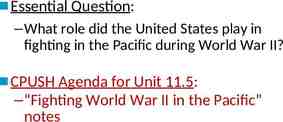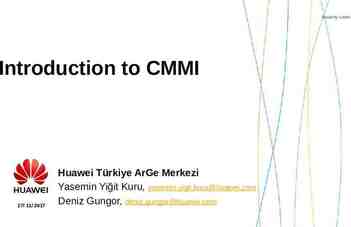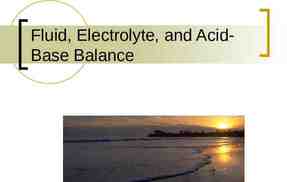POINTS OF ENTRY (POE) SIMULATION EXERCISE NOVEL
41 Slides1.89 MB

POINTS OF ENTRY (POE) SIMULATION EXERCISE NOVEL CORONAVIRUS (COVID-2019)

Agenda Part 1: Part 2: 08:45 Registration 09:00 Re-cap 09:00 09:10 Introduction 09:15 Exercise Objectives and how to play 09:15 Gaps analysis & action planning (group work) 10:45 Table-top Simulation 11:00 Coffee break (15 min) 11:30 12:30 Table-top Simulation 13:00 Hot-wash 12:30 13:00 Close part 1 Lunch 10:30 Coffee break (15 min) 10:45 Action planning continued (group work) Consolidation in plenary 12:00 session Wrap up and next steps Closing

Latest WHO Situation Report The situation is evolving rapidly. Let’s have a look at the latest WHO SitRep. 20 October 2020

Guiding Preparedness and Response WHO, providing up to date, accurate advice During health emergencies like the COVID-19 pandemic, one of WHO’s most vital roles is to gather data and research from around the world, evaluate it, and then advise countries on how to respond. Since January 2020, WHO has published more than 100 documents about COVID-19. Of these, more than half are detailed technical guidance, on how to find and test cases, how to provide safe and appropriate care for people depending on the severity of their illness, how to trace and quarantine contacts, how to prevent transmission from one person to another, how to protect health care workers, and how to help communities to respond appropriately. 20 October 2020

What is a Table-Top Exercise (TTX)? A tabletop exercise (TTX) is a discussion based event that uses a progressive simulated scenario, together with series of scripted injects, to make participants consider the impact of a potential health emergency on existing plans, procedures and capacities. “A TTX simulates an emergency situation in an informal, stress-free environment.” -WHO Exercise Manual, 2017

Design & Purpose Exercise Design This exercise challenges countries and public health actors to evaluate the public health plans and structures required at major points of entry for screening and managing suspect cases of COVID-19. The exercise is based on the published COVID-19 Points of Entry Guidance documents, including; 1. 2. 3. 4. Considerations for quarantine of contacts of COVID-19 cases (Aug 2020) Controlling the spread of COVID-19 at ground crossings (May 2020) Management of ill travellers at points of entry (March 2020) Promoting public health measures in response to COVID-19 on cargo ships and fishing vessels (Aug 2020) 5. Operational considerations for managing COVID-19 cases and outbreaks in aviation (March 2020) 6. Operational considerations for managing COVID-19 cases and outbreaks on board ship s (March 2020) Purpose Through facilitated group discussion, this exercise aims to examine and strengthen your existing plans, procedures and capabilities for managing COVID-19 cases in international travel including in aviation and ground crossings. 20 October 2020

Specific objectives of the TTX Improve the national, regional and/or district action plans to enhance your operations, at points of entry Share information on response capabilities, plans and procedures at points of entry. Review of the operational management process for travellers arriving (and possibly departing) through points of entry Confirm arrangements for notification, coordination and internal communications when managing individuals or groups arriving from areas affected by COVID-19. Confirm procedures related to the management of a suspected cases before and after laboratory confirmation. Review risk and media communication plans.

Exercise management team Roles Facilitation: (xxxxx) Rapporteurs: (Group note takers) Observers: (All partners)

Target participants Target participants for the TTX are all stakeholders at POEs mainly; Representatives from port health, Surveillance officers, Airlines or transportation companies, Airport authorities etc. Staff involved in management of facilities

Rules of the TTX This is NOT a test of individual staff competencies Respect the views of others Respond as you would in real life and allow others to do likewise Use your existing plans, guidelines and regulations to inform your responses Focus on solutions

Rules of the TTX (Cont.) Accept the scenario, do not fight it! The terms isolation and quarantine are often used interchangeably but as per the IHR (2005) differ: “isolation” means separation of ill or contaminated persons or affected baggage, containers, conveyances, goods or postal parcels from others in such a manner as to prevent the spread of infection or contamination; “quarantine” means the restriction of activities and/or separation from others of suspect persons who are not ill or of suspect baggage, containers, conveyances or goods in such a manner as to prevent the possible spread of infection or contamination; For the sake of this exercise the term “quarantine” will be considered to be the one used in the public domain, that loosely defines quarantine as any type of confinement or restrictions or persons or goods with respect to COVID-19.

Table-Top Exercise: How to Play Scenario Questions & Discussion (5) Hot-Wash SIMULATION EXERCISE Questions & Discussion (1) Questions & Discussion (4) Scenario update Scenario update Facilitated Debriefing NOVEL CORONAVIRUS (COVID-19) Questions & Discussion (2) Questions & Discussion (3) Action Planning Friday, December 23, 2022 This is a closed exercise, designed just for you. The facilitators will guide you through a series of discussions focused on an imported case of COVID-19 We are all here to learn page 12

Questions ANY QUESTION BEFORE WE START

HEALTH EMERGENCY POINTS OF ENTRY (POE) Simulation Exercise NOVEL CORONAVIRUS (COVID-2019) STARTEX

Session 1 - Scenario SIMULATION ONLY Early in 2020, particularly between March and May, the number of cases of COVID-19 surged as countries struggled to adapt to the emergence of a new pandemic virus. The travel industry was devastated by the virus with passenger numbers and flights falling by over 50% Most countries have imposed significant restrictions with almost all countries requiring some form of quarantine for new arrivals Arrival models vary from no quarantine and an instruction to isolate at home if a person feels unwell, to compulsory isolation at home (or at a hotel or temporary home) through to mandatory quarantine with arrivals taken to a designated hotel or facility OECD estimates on the COVID-19 impact point to 60% decline in international tourism in 2020. This could rise to 80% if recovery is delayed until December. This has already led to several airlines closing and thousands of job losses. SIMULATION EXERCISE NOVEL CORONAVIRUS (COVID-19) 20 October 2020 Data: 01/10/2020 page 14

Session 1 – Discussion Questions Questions for discussion Describe your current processes for managing international travellers and returning citizens arriving in the country? Do the arrival procedures vary by how they arrive (airport, land border or by sea)? Examine your plans. Ona flip Are they consistent with the current processes being implemented? chart compare actual requirements, your legal framework and your current published plans? Based on your answers above, list your strengths and weaknesses. 1. 30 mins

Session 2 - Note to Facilitators This exercise now has two differing scenarios you can choose depending on the circumstances of your country 1. The first is to test procedures in countries that do not have a quarantine or isolation policy in place 2. The second involves self quarantine arranged by the traveler him/her self. The person is required to stay at home or in a hotel or other accommodation. The traveller is responsible for arranging the details and must travel by the most efficient means to that location and stay there for 10 to 14 days You can use more than one of these scenarios if you would like to explore different options. You may also consider using one of the scenarios to explore approaches to managing arrivals that you are currently not using or might be considering.

Session 2 Option 1 – Countries with no quarantine As person has contacted a local doctor and has described symptoms consistent with COVID-19. This is a national of your country and has recently returned from a country with high infection rates The department of health or your equivalent has sent a testing team and has taken a specimen for analysis and you expect the result in the next 24-48 hours The person arrived in the country by air 5 days ago and started to feel unwell yesterday with symptoms becoming progressively worse The person travelled on the national carrier. They described the aircraft as half full and that the crew took recommended safety precautions (masks, sanitiser and distributed seating arrangements). Boarding was orderly. At the departure airport security was described as chaotic with people pushed close together at security and security teams requiring people to remove masks in crowded areas to verify identities. Since arriving home the suspected case has been out locally and has mixed with friends and family SIMULATION ONLY

Session 2 - Option 1 Discussion Questions Questions for discussion What plans, procedures and resources would you activate at this point? Who will be engaged, why and how? Does the infected person need to be further evaluated or isolated at another location or can they isolate at home? If they will be taken elsewhere, how is this done? Are there any other considerations regarding the other passengers, crew? What tracing measures need to be implemented? What is your legal framework for action? Based on your answers above, list your strengths and weaknesses. 30 mins

Session 2 Option 2 – Countries with self quarantine As person has contacted a local doctor and has described symptoms consistent with COVID-19. This is a national of your country and has recently returned from country with high infection . rates. On arrival this person was collected by his family and was driven immediately home. Prior to their arrival the family had purchased provisions for 14 days quarantine and they have not left the house. The family of four are all quarantined together and have had no contact with any other person The flight the person arrived on has continued to operate with the same crew since the case arrived home On the flight were 22 other people seated around the aircraft. The infected person described the aircraft as new and that the crew took recommended safety precautions (masks, sanitiser and distributed seating arrangements). Boarding was orderly. Reporting forms were completed. The ministry of health (or your equivalent) has sent inspectors to the homes of the other 21 passengers. They discovered the following; 7 were not at home or at the place designated on their reporting form 3 had people from outside their family group visiting at the time 4 showed symptoms of COVID-19 and one of these stated that they has visited their doctor that morning and had been tested and required to isolate (results in 24-48 hours). 7 were isolating according to the guidelines and have no symptoms SIMULATION ONLY

Session 2 - Option 2 Discussion Questions Questions for discussion What plans, procedures and resources would you activate at this point? Who will be engaged, why and how? Does the infected person need to be further evaluated or isolated at another location or can they self-isolate at home?If they will be taken elsewhere, how is this done? Are there any other considerations regarding the other passengers, crew? What will you do about the 7 people not at home? What will you do about the people with visitors? What will you do with the people showing symptoms What is your legal framework for action? What extra powers do you have to enforce isolation or issue notices for compliance (fines or other sanctions) Based on your answers above, list your strengths and weaknesses. 1. 30 mins

Break Coffee Break (15min)

Session 3 – Cargo vessel The cargo ship Maersk Orion has reported that they have a medical emergency on board and have requested to dock at a designated entry point. The vessel has a crew of 23 personnel consisting of officers (master, first engineer), specialist technicians (electricians, mechanics), and lower level crews or “ratings” (deck hands, cooks, and oilers). The ship departed a country with high rates of COVID-19 6 days ago Five of the crew have COVID-19 symptoms and one of the crew is in a very serious condition and is on supplemental oxygen The weather at sea makes by rescue dangerous and the ships helicopter has permission to dock and offload the affected crew requested master The ships master is keen to put to sea again with minimum delay SIMULATION ONLY

Session 3 Questions for discussion What plans, procedures and resources would you activate at this point? Which stakeholders will be engaged, why and how? How do you disembark crew, and what steps do you need to take? What IPC measures will you take? What standards will be used for decontamination? How will you manage the rest of the crew? Will you permit the ship to dock and if so, how long will you require the ship to remain in port If the ship cannot dock for any reason how will you manage the situation? What legal frameworks can you use? Based on your answers above, list your strengths and weaknesses. 30 mins

Session 4 – Land Crossings Since the emergence of COVID-19 many countries have attempted to restrict movement across borders. One of the most challenging points of entry are land borders as while all countries with land borders have some form of border designation, different countries have in the past had different approaches. Some countries, for example EU member states, have freedom of Some movement and have removed border checks and restrictions. countries have reintroduced some checks, but usually only checks health Some countries have land borders with official crossing points but also have a number of informal and unofficial crossing points where hundreds of miles of border are unmanned. Countries have restricted the movement of people across land borders, particularly when people are coming from countries with a high rate of transmission. Much of this restriction is carried out at formal crossing points You have been receiving reports that some people have been using informal crossing points to evade COVID-19 checks. SIMULATION ONLY

Session 4 Questions for discussion What approach are you taking to land border management? How are you screening people? What requirements are in place for people arriving from countries with a high infection rate? How are you managing informal entries into the country through informal border crossings? What are you doing about people who test positive or show symptoms of COVID-19 (such as a high temperature reading)? What will you do if one or two people on a bus or train test positive? What legal frameworks are in place to support your decisions? What equipment is available to manage border crossings and is this sufficient? Based on your answers above, list your strengths and weaknesses. 30 mins

Session 5 – Risk Communication It has been almost a year since the first case of COVID-19 was identified. In early March and April, many countries saw strict entry and exit requirements put in place to try to contain or limit the spread. Since that time, some of the requirements have been adjusted to reflect a better understanding of how the virus is transmitted. For the travel and tourism industry, the effect has been catastrophic with companies out of business and widespread job losses. Many commentators in the industry are now openly critical of government policies and heavily criticise measures as ineffective and leading to unnecessary hardship. Social media is alive with complaints about lost journeys, difficulties seeing loved ones and seemingly unnecessary hardship caused by isolation. Pressure on governments around the world is immense to relax restrictions. Governments are being accused of going too far and trying to cover up early mistakes. Some people in quarantine are actively ignoring advice and requirements thinking that the likelihood of being caught is very low and that their individual actions make no difference in spreading the illness. SIMULATION ONLY

Session 5 Questions for discussion What is your strategy for media communication and who is leading this? How are you communicating point of entry requirements? What communication needs to take place and to whom? How are you reaching travellers before they arrive? What legal frameworks need to be communicated? How are you managing the media, including social media? How are you managing misinformation and rumour? How will information and communication be coordinated? Based on your answers above, list your strengths and weaknesses. 30 mins

ENDEX

Hot-Wash Initial feedback from the participants

Summary & Next Steps Part II: GAP analysis: Focus group discussion to review readiness checklist Action planning Participants evaluation form

Agenda part 2 Part 2: 09:00 Re-cap 09:15 Strengths & Gaps analysis (group work) 10:30 Coffee break (15 min) 10:45 Action planning (group work) 11:30 Consolidation in plenary 12:00 session Wrap up and next 12:30 steps Closing

Strengths and gaps analysis Review strengths & gaps TASKS: 1. 2. Check assumptions Propose ideas to enhance your systems, plans & Procedures ACTION PLAN 3. 75 mins In groups, divide a piece of paper into three sections. Review the Readiness Checklist, your plans and notes from your TTX Discuss and write your points in each of the sections to answer: What worked well? (Achievements) What was challenging? (Challenges) Recommendations? (and prioritize, to identify your top 3) Note: the action plan will be done in the next session

Break Coffee Break (15min)

Action Plan Key Challenge/ Gap Proposed Solution Timeline for Resolution Responsibility 45 mins SIMULATION EXERCISE NOVEL CORONAVIRUS (COVID-19) Friday, December 23, 2022 page 35

Consolidation

Participants’ feedback form Your feedback will assist us to maintain and improve the quality and relevance of future simulation exercises. 5 mins

Next steps and wrap up NEXT STEPS

WHO COVID-19 Partners Platform The COVID-19 Partners Platform supports transparency, collaboration, and efficiency for countries, UN agencies, implementing partners, and donors in their COVID-19 response. In the country checklist you may wish to update the indicator related to the PoE pillar on conducting this Simulation Exercise. For more information visit: https://covid19partnersplatform.who.int/

E-learning courses The following eLearning courses are available here: Operational considerations for managing COVID-19 cases and outbrea ks on board ships Management of ill travelers at points of entry in the context of the COVI D-19 outbreak Operational considerations for managing COVID-19 cases and outbrea ks in aviation Controlling the Spread of COVID-19 at Ground Crossings

THANK YOU! For SimEx technical support, please contact your WHO country office or regional office focal point: AFRO: [email protected] EMRO: [email protected] EURO: [email protected]; [email protected] PAHO: [email protected] SEARO: [email protected]; [email protected] WPRO: [email protected]; WHO RESOURCES WHO COVID-19 Emergency webpage More information on coronavirus WHO resources on simulation exercises Scan or Click Scan or Click Scan or Click






